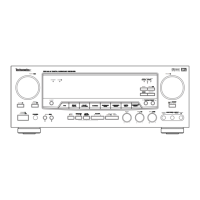-7-
Connecting the PRE OUT jacks
This unit is equipped with Subwoofer and Center
PREOUT jacks. These jacks allow connection off an
optional powered subwoofer and connection of the
center channel output to specially equipped TV’s that
will play the center channel through the TV speakers.
Note :
Subwoofer preout signals are not amplified.
Therefore, when using the Subwoofer out jack, you
must use a subwoofer with built-in amplifier.
Notes :
If a speaker is connected directly to the PRE OUT jack
without an amplifier connected, no sound comes
from the speaker.
Subwoofer speakers are optional and are not
required.
Center Speaker
Power Amplifier
Power Amplifier
or
Subwoofer with
Subwoofer without
SWITCHED :
These outlets are only active when the receiver is turned
on.
Caution :
Make sure that the total power consumption of all
equipment connected to the outlets on the receiver
does not exceed 100 watts.
AC OUTLETS

